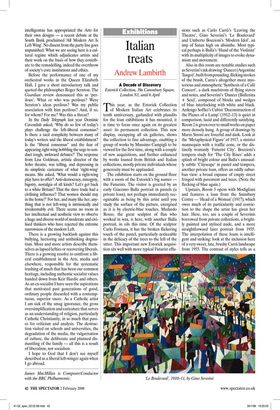Italian treats
Andrew Lambirth
A Decade of Discovery Estorick Collection, 39a Canonbury Square, London N1, until 6 April
This year, as the Estorick Collection of Modern Italian Art celebrates its tenth anniversary, garlanded with plaudits for the loan exhibitions it has mounted, it is time to focus once again on its greatest asset: its permanent collection. This new display, occupying all six galleries, shows the collection to fine advantage, enabling a group of works by Massimo Campigli to be viewed for the first time, along with a couple of new acquisitions, and further enhanced by works loaned from British and Italian collections, mostly private individuals whose generosity must be applauded.
The exhibition starts on the ground floor with a room of the Estorick’s big names — the Futurists. The visitor is greeted by an early Giacomo Balla portrait in pastels (a private loan), not perhaps immediately recognisable as being by this artist until you study the surface of the picture, energised as it is by electric-blue touches. Medardo Rosso, the great sculptor of flux who worked in wax, is here, with another Balla portrait, in oils this time. Of the sculptor Carlo Fontana, it has the broken flickering touch of the pastel, particularly noticeable in the delicacy of the trees to the left of the sitter. This important new Estorick acquisition sits well with more typical Futurist effu sions such as Carlo Carrà’s ‘Leaving the Theatre’, Gino Severini’s ‘Le Boulevard’ and Umberto Boccioni’s ‘Modern Idol’, an imp of Satan high on absinthe. Most typical perhaps is Balla’s ‘Hand of the Violinist’ with its multiplicity of images to evoke dynamism and movement.
Also in this room are notable studies such as Severini’s ink drawing ‘Dancer (Argentine Tango)’, built from pounding, flicking strokes of the brush, Carra’s altogether more mysterious and atmospheric ‘Synthesis of a Café Concert’, a dark maelstrom of flying staves and notes, and Severini’s ‘Dancer (Ballerina + Sea)’, composed of blocks and wedges of blue interlocking with white and black. Ardengo Soffici’s Cubist ‘Deconstruction of the Planes of a Lamp’ (1912–13) is quiet in comparison, lucid and differently satisfying. Room 2 is given over to small works on paper more densely hung. A group of drawings by Mario Sironi are forceful and dark. Look at the ‘Metaphysical Figure’ of 1917, a sinister mannequin with a traffic cone, or the distinctly womanly ‘Futurist City’. Boccioni’s tempera study for ‘The City Rises’ adds a splash of bright colour and Balla’s unusually subtle ‘Cityscape’ in pastel and tempera, another private loan, offers an oddly suburban view: a broad expanse of empty street fringed with pavement and trees. (Note the flecking of blue again.) Upstairs, Room 3 opens with Modigliani and features a loan from the Sainsbury Centre — ‘Head of a Woman’ (1917), which owes much of its particularity and conviction to the shape the artist has given her hair. Here, too, are a couple of Severinis borrowed from private collections, a brightly painted and stylised nude, and a more straightforward later portrait from 1935. The interpolation of these loans is intelligent and striking: look at the inclusion here of a very sweet, late, brushy Carrà landscape from 1955. The contrast of styles tells us a lot about the artists and their development visà-vis personality, tradition and experiment.
Room 4 is devoted to Morandi, and this display alone makes a visit to the Estorick a must. Apart from a loaned oil from the Morandi Museum in Bologna, the works are in black and white, consisting of etchings and drawings. These may at first glance seem undramatic and unrewarding, but look more closely to discover the richness lurking in even the most minimal of pencil drawings. Morandi’s control of line is phenomenal, and his ability to summon forth a landscape or still-life from an arrangement of crosshatching is unparalleled. ‘Savena Landscape’ (1929) remains my favourite.
Upstairs again for the artist I find most appealing in this whole impressive collection: Zoran Music (1909–2005). I love the gentle lyricism and muted palette of his ‘Horses and Landscape’ (1951), ‘Black Mountain’ (1952) and ‘Corsican Motif’ (1966). Here, too, is Campigli with a wall to himself: curious imagery, much to do with women on display. And finally, in Room 6, Marino Marini — I liked his bronze wall sculpture ‘Quadriga’ — and lots more Sironi. For me, a little Sironi goes a long way. Some artists suffer from being shown in bulk. I enjoyed the Estorick Modiglianis almost more than his big recent solo show at the RA. But this is a room of strong flavours, with Renato Guttuso and Emilio Greco as well. It’s quite a range. We’re fortunate indeed to have this remarkable collection on public view in London.



































































 Previous page
Previous page